The Buffering Skincare Products Market is expected to record a valuation of USD 3,605.4 million in 2025 and USD 7,906.8 million in 2035, with an increase of USD 4,301.4 million, which equals a growth of 193% over the decade. The overall expansion represents a CAGR of 8.2% and a 2X increase in market size.
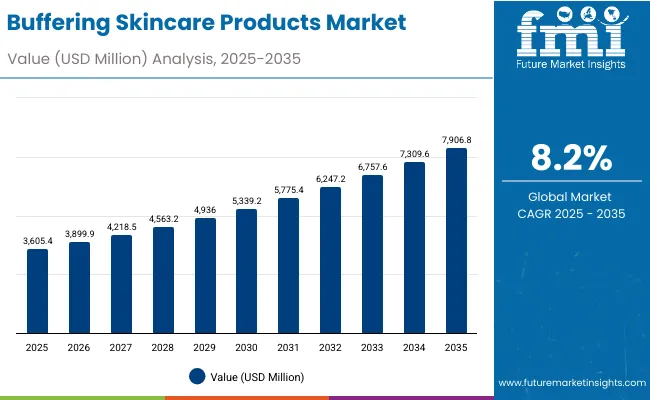
Buffering Skincare Products Market Key Takeaways
| Metric | Value |
|---|---|
| Buffering Skincare Products Market Estimated Value (2025E) | USD 3,605.4 million |
| Buffering Skincare Products Market Forecast Value (2035F) | USD 7,906.8 million |
| Forecast CAGR (2025 to 2035) | 8.2% |
During the first five-year period from 2025 to 2030, the market increases from USD 3,605.4 million to USD 5,339.2 million, adding USD 1,733.8 million, which accounts for 40% of the total decade growth. This phase records steady adoption of pH-balancing creams and sodium bicarbonate-based formulations, driven by rising awareness of pH restoration and skin barrier repair in premium skincare. Women’s skincare products dominate this period as they cater to over 58% of total market demand.
The second half from 2030 to 2035 contributes USD 2,567.6 million, equal to 60% of total growth, as the market jumps from USD 5,339.2 million to USD 7,906.8 million. This acceleration is powered by wider acceptance of sensitive-skin balance formulations, increased sales through e-commerce channels, and rising demand for amino acid buffer systems in dermatological lines. Asia-Pacific markets, led by China and India, together capture a growing share above 40% by the end of the decade. Product innovation in post-procedure and pH-stabilizing creams continues to drive long-term expansion.
From 2020 to 2024, the Buffering Skincare Products Market witnessed consistent expansion, supported by growing consumer preference for mild, pH-stabilizing, and sensitive-skin formulations. During this period, the competitive landscape was dominated by dermatology-led skincare brands, collectively accounting for nearly 70% of global revenue. Brands such as La Roche-Posay, CeraVe, and Paula’s Choice strengthened their foothold in pharmacy and e-commerce channels, emphasizing dermatologically tested formulations, microbiome protection, and acid mantle repair. The market’s early growth phase relied primarily on cream-based and toning formats, while soothing gels and mist formulations remained niche.
Demand for Buffering Skincare Products is expected to expand to USD 7,906.8 million by 2035, as consumer awareness of skin pH balance and barrier health accelerates globally. The revenue mix is shifting toward amino acid and lactic acid buffer systems, integrated with sensitive-skin and post-procedure care routines. Traditional clinical brands are now facing competition from cosmeceutical startups leveraging AI-driven skin diagnostics, customized formulation platforms, and subscription-based skincare ecosystems. The competitive advantage is moving from single-ingredient innovation toward personalized skin biology mapping, digital skincare monitoring, and long-term treatment adherence models.
Growing consumer awareness around maintaining optimal skin pH and strengthening the acid mantle is driving sustained adoption of buffering skincare products. With increasing cases of sensitivity and irritation caused by pollution, stress, and over-exfoliation, consumers are shifting to pH-balanced creams, toners, and cleansers that restore skin equilibrium. Dermatologist-endorsed brands and clinical formulations emphasizing gentle, non-stripping ingredients such as sodium bicarbonate and amino acid buffers are gaining prominence across both premium and mass-market categories globally.
The Asia-Pacific region, particularly China and India, is witnessing rapid growth due to strong online retail penetration and heightened consumer education on skincare science. Affordable access to dermatologist-approved buffering products through e-commerce platforms has significantly widened the consumer base. Furthermore, rising disposable incomes, urbanization, and an expanding middle-class population are fueling demand for clinically tested, pH-stabilizing products designed for sensitive and post-procedure skin care, strengthening long-term market expansion in emerging economies.
The Buffering Skincare Products Market is segmented by product type, key ingredients, skin concern, distribution channel, end user, and region. Product types include pH-balancing creams, toners & mists, face cleansers, and soothing gels each serving distinct skincare routines focused on pH restoration and barrier protection. Key ingredient segmentation covers sodium bicarbonate, amino acid buffers, citrate buffers, and lactic acid blends, representing diverse formulation bases.
By skin concern, the market addresses sensitive-skin balance, post-procedure care, and acid mantle restoration. Major distribution channels include e-commerce, pharmacies/drugstores, specialty beauty retail, and dermatology clinics. End users span women, men, teens, and sensitive-skin consumers, with regional coverage extending across North America, Europe, East Asia, South Asia & Pacific, Latin America, and the Middle East & Africa.
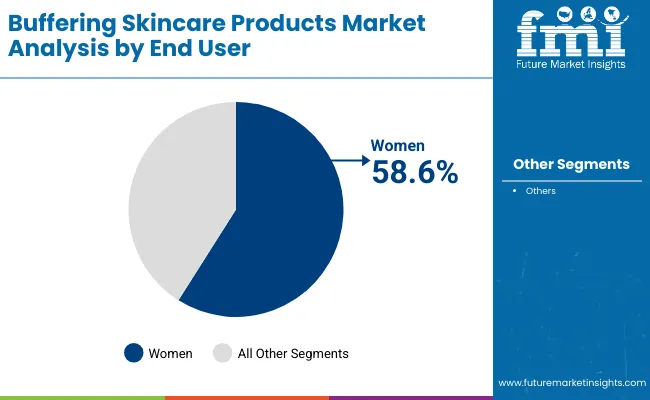
| End User | Value Share% 2025 |
|---|---|
| Women | 58.6% |
| Others | 41.4% |
The women’s segment is anticipated to command 58.6% of the Buffering Skincare Products Market revenue in 2025, maintaining its dominance throughout the forecast period. Growth is primarily attributed to increasing consumer awareness of skin pH balance, heightened sensitivity concerns, and the growing preference for dermatologically tested, pH-stabilizing formulations. Women are the primary consumers of premium and clinical skincare lines emphasizing acid mantle restoration and post-procedure recovery. E-commerce platforms and social media-driven beauty education have further accelerated adoption, with a noticeable rise in repeat purchases across urban markets.
Manufacturers are increasingly customizing formulations to address hormonal fluctuations, environmental stressors, and ingredient transparency factors influencing purchase behavior. This segment’s leadership is reinforced by strong participation from professional women aged 25-45, who prioritize functional skincare backed by clinical efficacy. Consequently, the women’s category remains the largest and most influential demographic shaping future growth in the buffering skincare landscape.
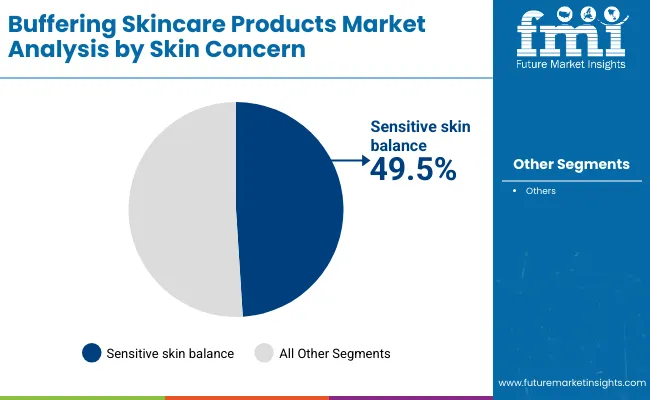
| Skin Concern | Value Share% 2025 |
|---|---|
| Sensitive skin balance | 49.5% |
| Others | 50.5% |
The sensitive-skin balance segment is expected to hold 49.5% of the Buffering Skincare Products Market share in 2025, driven by rising global incidences of sensitivity, dryness, and barrier impairment caused by pollution, stress, and excessive exfoliation. Consumers increasingly seek pH-balanced formulations that restore the skin’s natural equilibrium and prevent irritation, leading to higher adoption of products formulated with amino acid and bicarbonate buffers.
This category’s strength also stems from dermatologists’ recommendations for gentle, non-stripping cleansers, toners, and creams suited for reactive skin types. As awareness of the acid mantle’s role in overall skin health deepens, demand for scientifically formulated buffering products continues to expand. Brands are innovating with lightweight, microbiome-friendly ingredients and post-procedure care solutions tailored for sensitive skin recovery. Consequently, the sensitive-skin balance segment is expected to retain leadership throughout the forecast period, establishing itself as a core growth driver within the global market.
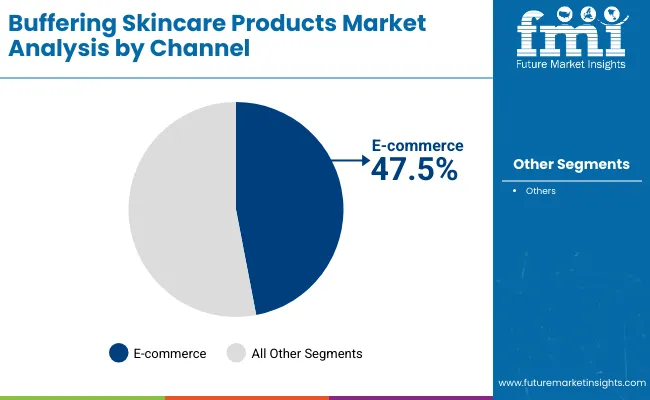
| Channel | Value Share% 2025 |
|---|---|
| E-commerce | 47.5% |
| Others | 52.5% |
The e-commerce segment is projected to account for 47.5% of the Buffering Skincare Products Market revenue in 2025, establishing it as the fastest-growing distribution channel. This growth is driven by rising consumer preference for online beauty retail platforms, increased accessibility to dermatologist-recommended products, and the availability of detailed ingredient information supporting purchase decisions. Digital-first skincare brands have accelerated adoption through personalized quizzes, subscription models, and influencer-driven awareness campaigns.
Convenience, wider product assortments, and frequent promotional offers have further strengthened consumer migration from traditional retail to online platforms. The segment also benefits from advanced logistics networks that ensure faster deliveries and secure packaging of temperature-sensitive skincare products. With consumers valuing transparency and expert-backed reviews, e-commerce platforms have become a trusted source for premium and clinical-grade buffering skincare lines. Consequently, online channels are expected to maintain strong momentum, driving consistent global growth through 2035.
Growing Awareness of Skin pH Balance and Acid Mantle Protection
The rising understanding of skin biology, particularly the importance of maintaining optimal pH levels for barrier integrity, is fueling market growth. Consumers are increasingly aware that harsh cleansers and exfoliants can disrupt the acid mantle, leading to irritation and breakouts. Consequently, demand for buffering skincare products especially those containing mild, pH-balancing ingredients such as amino acid buffers and sodium bicarbonate is surging. Dermatologists and aesthetic clinics are further promoting pH-restoring creams and toners, driving adoption across both premium and mass-market skincare categories globally.
Expansion of Dermatology-Backed and Clinical Skincare Lines
The market is benefiting from the rapid growth of dermatologist-endorsed and clinically formulated skincare brands emphasizing barrier repair and gentle efficacy. Consumers now favor products validated through dermatological testing and minimal-irritation claims. Brands such as La Roche-Posay, CeraVe, and Paula’s Choice are expanding global reach through pharmacies and e-commerce channels, offering formulations with proven acid-buffering technologies. This clinical credibility enhances consumer trust, particularly among sensitive-skin users. As post-procedure and medical skincare become mainstream, buffering formulations are expected to remain integral to advanced dermatological regimens worldwide.
Limited Consumer Understanding of Buffering Ingredients
Despite growing awareness, many consumers remain unfamiliar with the science behind buffering agents and their function in maintaining skin pH stability. Misinterpretations surrounding "acidic" or "alkaline" formulations often discourage purchase decisions, especially among new users. Inadequate labeling transparency and inconsistent ingredient education across brands further limit wider adoption. This knowledge gap hampers demand growth in emerging markets, where consumer preferences still lean toward fragrance-rich or cosmetic skincare rather than functionally balanced formulations. Overcoming this restraint requires focused educational campaigns and clearer on-pack communication about the role of buffering agents in long-term skin health.
Integration of AI and Skin Microbiome Diagnostics in Personalized Skincare
The Buffering Skincare Products Market is witnessing a technological shift toward personalized skincare supported by AI-driven diagnostics and microbiome analysis. Digital skin-mapping tools and smartphone-based pH analyzers are enabling consumers to select products precisely tailored to their skin’s sensitivity and acidity levels. Brands are leveraging this data to design customized buffering formulations that maintain the natural microbiome while restoring barrier function. This convergence of digital diagnostics with dermatological science is transforming skincare from generalized routines to individualized regimens, marking a major step toward intelligent, precision-based skincare solutions.
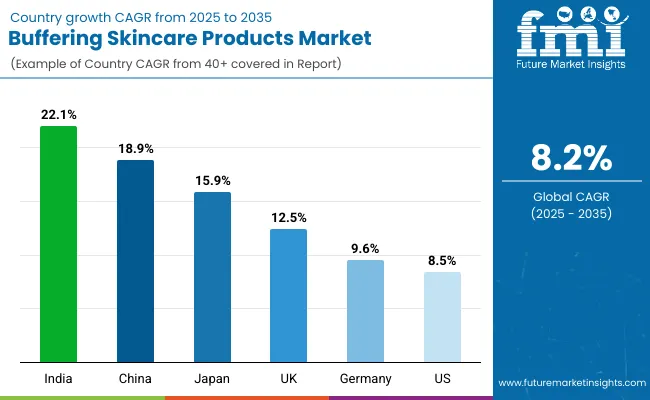
| Countries | Estimated CAGR (2025 to 2035) |
|---|---|
| China | 18.9% |
| USA | 8.5% |
| India | 22.1% |
| UK | 12.5% |
| Germany | 9.6% |
| Japan | 15.9% |
The global Buffering Skincare Products Market shows strong regional variation in adoption and growth, primarily influenced by consumer awareness, dermatological infrastructure, and product availability. Asia-Pacific emerges as the fastest-growing region, led by India (22.1%) and China (18.9%), driven by rapid skincare market expansion, digital beauty retail penetration, and growing demand for sensitive-skin and pH-balancing formulations. India’s younger demographic and high smartphone usage support accelerated adoption through e-commerce and influencer-driven education.
China benefits from rising disposable incomes, local K-beauty influence, and a preference for clinical-grade formulations. Japan (15.9%) sustains growth through innovations in amino acid buffer systems and probiotic-based skincare. Europe, led by the UK (12.5%) and Germany (9.6%), maintains stable demand supported by established pharmaceutical skincare brands and strict regulatory frameworks. North America, anchored by the USA (8.5%), shows steady expansion through pharmacy-led distribution and clinical endorsement, emphasizing dermatologist-tested, pH-stabilizing products for sensitive skin.
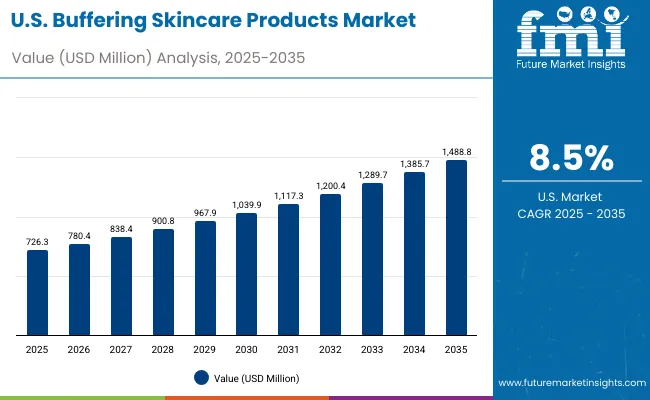
| Year | USA Buffering Skincare Products Market (USD Million) |
|---|---|
| 2025 | 726.3 |
| 2026 | 780.4 |
| 2027 | 838.4 |
| 2028 | 900.8 |
| 2029 | 967.9 |
| 2030 | 1039.9 |
| 2031 | 1117.3 |
| 2032 | 1200.4 |
| 2033 | 1289.7 |
| 2034 | 1385.7 |
| 2035 | 1488.8 |
The Buffering Skincare Products Market in the United States is projected to grow at a CAGR of 8.5% from 2025 to 2035, driven by the increasing consumer preference for dermatologist-approved, pH-stabilizing skincare formulations. Growth is fueled by rising concerns over skin sensitivity, pollution exposure, and barrier disruption caused by over-exfoliation. Dermatology clinics and pharmacy-led brands such as CeraVe, La Roche-Posay, and Clinique are leading with formulations that balance skin pH and restore the acid mantle. The expansion of e-commerce and subscription skincare platforms has further boosted accessibility. Consumers are increasingly adopting daily pH-balancing creams and soothing cleansers as part of minimal, science-backed routines.
The Buffering Skincare Products Market in the United States is projected to grow at a CAGR of 8.5% from 2025 to 2035, supported by a strong preference for dermatologist-approved and clinically tested formulations. Demand is led by rising skin sensitivity awareness, post-procedure care routines, and growing usage of pH-balancing creams in daily skincare. Consumers increasingly favor gentle, barrier-restoring products that prevent irritation caused by environmental stress and over-exfoliation. The expansion of dermatology clinics and pharmacy-led skincare brands such as CeraVe, Clinique, and Paula’s Choice has further enhanced accessibility. The USA market also benefits from digital skincare diagnostics, subscription-based e-commerce models, and influencer-driven awareness campaigns targeting sensitive-skin users.
India is witnessing one of the fastest growth trajectories in the Buffering Skincare Products Market, forecast to expand at a CAGR of 22.1% through 2035. Rapid urbanization, rising disposable incomes, and increased skincare awareness in tier-2 and tier-3 cities are driving widespread adoption. Consumers are shifting from conventional cosmetics to clinically tested, pH-balancing formulations addressing sensitivity, acne, and pollution-related skin issues.
Domestic and international brands are expanding presence through e-commerce platforms, dermatology clinics, and pharmacy outlets. Educational content on pH balance and barrier care shared via social media influencers is further stimulating consumer engagement. India’s young demographic, strong digital penetration, and preference for affordable premium skincare products continue to accelerate demand.
The Buffering Skincare Products Market in China is projected to grow at a CAGR of 18.9% from 2025 to 2035, the highest among major economies. Growth is driven by rapid consumer adoption of pH-balancing and sensitive-skin formulations, alongside increasing preference for dermatologist-endorsed and clinically validated skincare products. Local skincare brands are innovating with amino acid and lactic acid buffer systems, offering affordable yet effective solutions for post-procedure and barrier-repair needs.
E-commerce giants such as Tmall and JD.com are reshaping distribution dynamics, with influencer collaborations amplifying brand visibility. Urban consumers are favoring lightweight formulations suitable for humid climates, while younger demographics drive experimentation with hybrid cleansing and toning routines. Rising disposable incomes, improved dermatological access, and growing awareness of acid mantle protection are reinforcing market expansion.
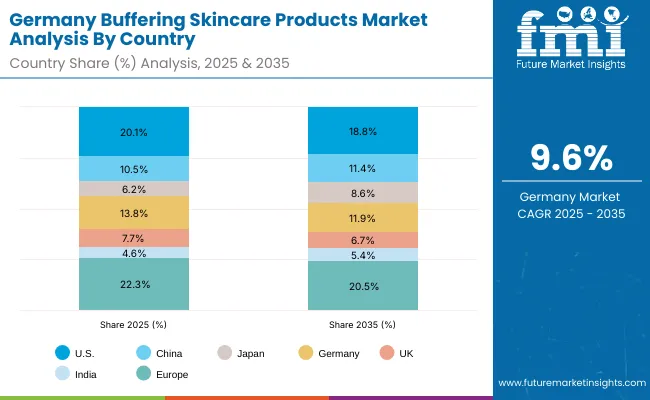
| Countries | 2025 Share (%) |
|---|---|
| USA | 20.1% |
| China | 10.5% |
| Japan | 6.2% |
| Germany | 13.8% |
| UK | 7.7% |
| India | 4.6% |
| Countries | 2035 Share (%) |
|---|---|
| USA | 18.8% |
| China | 11.4% |
| Japan | 8.6% |
| Germany | 11.9% |
| UK | 6.7% |
| India | 5.4% |
The Buffering Skincare Products Market in Germany is projected to grow at a CAGR of 9.6% from 2025 to 2035, supported by the country’s strong pharmaceutical and dermocosmetic industry. German consumers show a distinct preference for clinically validated, fragrance-free, and dermatologically tested formulations that align with EU cosmetic safety standards. Growth is being reinforced by the dominance of pharmacy and drugstore chains such as DM, Rossmann, and Müller, which serve as key distribution channels for medical skincare brands including Eucerin, La Roche-Posay, and Bioderma.
Awareness of acid mantle protection, pH regulation, and microbiome balance is expanding rapidly through dermatologist education programs and product labeling mandates. The country’s emphasis on sustainability and minimalistic formulations has also fueled the rise of eco-certified, vegan, and pH-stabilizing skincare lines.
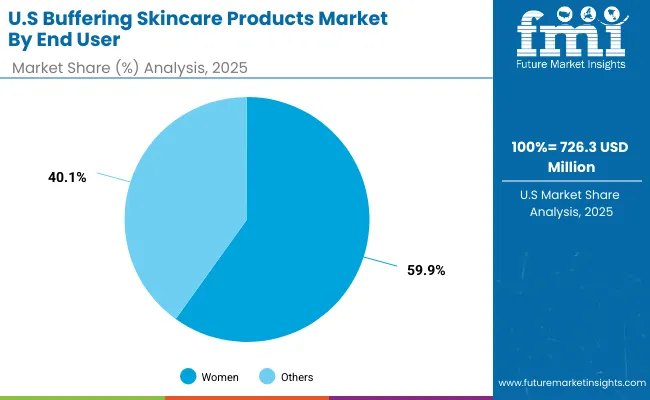
| USA by End User | Value Share% 2025 |
|---|---|
| Women | 59.9% |
| Others | 40.1% |
The Buffering Skincare Products Market in the United States is valued at USD 726.3 million in 2025, with women accounting for the dominant 59.9% share of total demand. Market expansion is supported by growing awareness of pH balance, acid mantle protection, and the need for dermatologist-recommended skincare for sensitive and post-procedure conditions. Leading brands such as CeraVe, Paula’s Choice, and Clinique are investing in barrier-repair formulations integrated with ceramides, amino acids, and mild exfoliating buffers.
The strong retail presence of pharmacy-based and clinical skincare brands continues to sustain adoption. Rising integration of AI-enabled skincare diagnostics and subscription-based personalized product lines is also influencing consumer preferences. Over the coming decade, the USA market is expected to witness steady growth through 2035, driven by innovation in ingredient science, expanding e-commerce access, and increased engagement with preventive skincare routines.
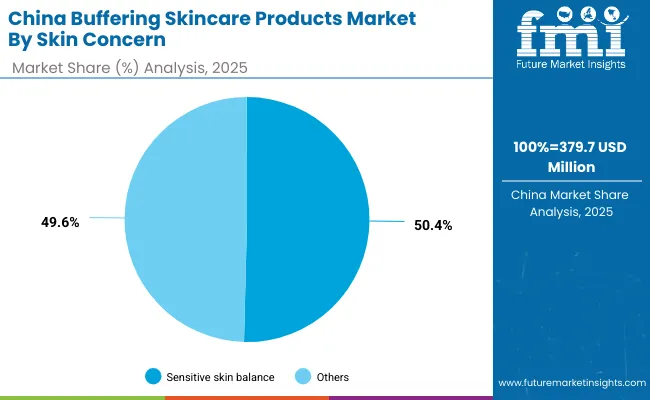
| China by Skin Concern | Value Share% 2025 |
|---|---|
| Sensitive skin balance | 50.4% |
| Others | 49.6% |
The Buffering Skincare Products Market in China presents strong opportunities, valued at USD 379.7 million in 2025, with sensitive-skin balance products leading at 50.4%. This dominance stems from a rising prevalence of sensitivity and irritation caused by pollution, climate variations, and chemical overuse in cosmetics. Chinese consumers increasingly favor dermatologist-endorsed and clinically validated skincare with pH-balancing formulations that strengthen the acid mantle. The shift toward "functional skincare" is amplified by strong e-commerce platforms such as Tmall, JD.com, and Xiaohongshu, which provide direct access to expert brands like La Roche-Posay and Bioderma. Domestic manufacturers are also leveraging amino acid and lactic acid buffers to create affordable, high-performance formulations suited for humid Asian climates.
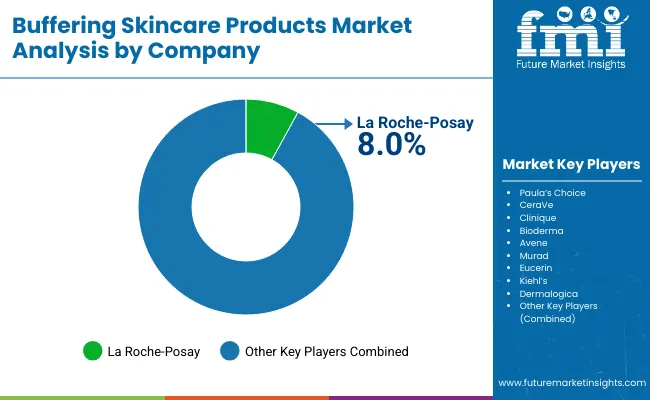
The Buffering Skincare Products Market is moderately fragmented, featuring a mix of multinational dermatology brands, clinical skincare innovators, and emerging cosmeceutical entrants. Global leaders such as La Roche-Posay, CeraVe, and Bioderma collectively dominate due to their strong dermatological heritage, extensive pharmacy presence, and credibility in pH-balancing formulations.
These brands focus on acid mantle protection, skin microbiome health, and post-procedure care, supported by clinical testing and dermatologist endorsements. Mid-sized brands including Paula’s Choice, Clinique, and Avene are expanding through e-commerce and digital skincare platforms, offering customized solutions for sensitive and reactive skin types. Meanwhile, regional players such as Kiehl’s, Eucerin, and Murad emphasize clean formulations, sustainability, and localized product innovation.
Competitive differentiation is shifting toward science-backed ingredients, personalization, and digital engagement with subscription skincare models, AI-based skin diagnostics, and eco-friendly packaging defining the next phase of competition in the global buffering skincare landscape.
Key Developments in Buffering Skincare Products Market
| Item | Value |
|---|---|
| Quantitative Units | USD 3,605.4 Million |
| Product Type | Toners & mists, pH-balancing creams, Face cleansers, Soothing gels |
| Key Ingredients | Sodium bicarbonate, Amino acid buffers, Citrate buffers, Lactic acid blends |
| Skin Concern | Acid mantle restoration, Post-procedure care, Sensitive skin balance |
| Channel | E-commerce, Pharmacies/drugstores, Specialty beauty retail, Dermatology clinics |
| End User | Women, Men, Teens, Sensitive-skin users |
| Regions Covered | North America, Europe, Asia-Pacific, Latin America, Middle East & Africa |
| Country Covered | United States, Canada, Germany, France, United Kingdom, China, Japan, India, Brazil, South Africa |
| Key Companies Profiled | La Roche-Posay, Paula’s Choice, CeraVe, Clinique, Bioderma, Avene, Murad, Eucerin, Kiehl’s, Dermalogica |
| Additional Attributes | Dollar sales by product type and end-user category, adoption trends in pH-balancing and sensitive-skin formulations, rising demand for dermatologist-tested and clinically validated buffering products, segment-specific growth across post-procedure care, acid mantle restoration, and sensitive-skin balance applications, revenue segmentation by ingredient type such as sodium bicarbonate, amino acid, and lactic acid buffers, integration of AI-driven skin diagnostics and personalized skincare platforms, regional trends influenced by urbanization and e-commerce expansion, and innovations in microbiome-friendly formulations, clean-label ingredients, and pH-stabilizing delivery systems enhancing long-term skin barrier performance. |
The global Buffering Skincare Products Market is estimated to be valued at USD 3,605.4 million in 2025.
The market size for the Buffering Skincare Products Market is projected to reach USD 7,906.8 million by 2035.
The Buffering Skincare Products Market is expected to grow at a 8.2% CAGR between 2025 and 2035.
The key product types in the Buffering Skincare Products Market are pH-balancing creams, toners & mists, face cleansers, and soothing gels, each formulated to maintain skin pH, restore the acid mantle, and support sensitive-skin balance.
In terms of skin concern, the sensitive-skin balance segment is projected to command a 49.5% share of the Buffering Skincare Products Market in 2025, driven by growing awareness of skin sensitivity, barrier repair, and dermatologist-recommended formulations designed for daily pH stabilization.






Our Research Products

The "Full Research Suite" delivers actionable market intel, deep dives on markets or technologies, so clients act faster, cut risk, and unlock growth.

The Leaderboard benchmarks and ranks top vendors, classifying them as Established Leaders, Leading Challengers, or Disruptors & Challengers.

Locates where complements amplify value and substitutes erode it, forecasting net impact by horizon

We deliver granular, decision-grade intel: market sizing, 5-year forecasts, pricing, adoption, usage, revenue, and operational KPIs—plus competitor tracking, regulation, and value chains—across 60 countries broadly.

Spot the shifts before they hit your P&L. We track inflection points, adoption curves, pricing moves, and ecosystem plays to show where demand is heading, why it is changing, and what to do next across high-growth markets and disruptive tech

Real-time reads of user behavior. We track shifting priorities, perceptions of today’s and next-gen services, and provider experience, then pace how fast tech moves from trial to adoption, blending buyer, consumer, and channel inputs with social signals (#WhySwitch, #UX).

Partner with our analyst team to build a custom report designed around your business priorities. From analysing market trends to assessing competitors or crafting bespoke datasets, we tailor insights to your needs.
Supplier Intelligence
Discovery & Profiling
Capacity & Footprint
Performance & Risk
Compliance & Governance
Commercial Readiness
Who Supplies Whom
Scorecards & Shortlists
Playbooks & Docs
Category Intelligence
Definition & Scope
Demand & Use Cases
Cost Drivers
Market Structure
Supply Chain Map
Trade & Policy
Operating Norms
Deliverables
Buyer Intelligence
Account Basics
Spend & Scope
Procurement Model
Vendor Requirements
Terms & Policies
Entry Strategy
Pain Points & Triggers
Outputs
Pricing Analysis
Benchmarks
Trends
Should-Cost
Indexation
Landed Cost
Commercial Terms
Deliverables
Brand Analysis
Positioning & Value Prop
Share & Presence
Customer Evidence
Go-to-Market
Digital & Reputation
Compliance & Trust
KPIs & Gaps
Outputs
Full Research Suite comprises of:
Market outlook & trends analysis
Interviews & case studies
Strategic recommendations
Vendor profiles & capabilities analysis
5-year forecasts
8 regions and 60+ country-level data splits
Market segment data splits
12 months of continuous data updates
DELIVERED AS:
PDF EXCEL ONLINE
Skincare Products Market Size and Share Forecast Outlook 2025 to 2035
Men’s Skincare Products Market Size, Growth, and Forecast for 2025 to 2035
Moisturizing Skincare Products Market Size and Share Forecast Outlook 2025 to 2035
Anti-Fatigue Skincare Products Market Size and Share Forecast Outlook 2025 to 2035
Incontinence Skincare Products Market Analysis by Product Type, Price, End-User, Sales Channel and Region 2025 to 2035
Anti-Inflammatory Skincare Products Market Size and Share Forecast Outlook 2025 to 2035
Allantoin Extract for Skincare Products Market Analysis – Trends, Growth & Forecast 2025 to 2035
Skincare Supplement Market Size and Share Forecast Outlook 2025 to 2035
Skincare Oil Market Size and Share Forecast Outlook 2025 to 2035
Buffering & Neutralizing Agents Market Size and Share Forecast Outlook 2025 to 2035
Skincare Nutritional Serum Market Size and Share Forecast Outlook 2025 to 2035
Products from Food Waste Industry Analysis in Korea Size, Share and Forecast Outlook 2025 to 2035
Products from Food Waste in Japan - Size, Share, and Forecast Outlook 2025 to 2035
Skincare Market Analysis - Size, Share, and Forecast Outlook 2025 to 2035
Products from Food Waste Market Analysis - Size, Growth, and Forecast 2025 to 2035
Skincare Packaging Market Size, Share & Forecast 2025 to 2035
Skincare Industry in India – Trends & Growth Forecast 2024-2034
Global Skincare Treatment Market Analysis – Size, Share & Forecast 2024-2034
USA Products from Food Waste Market Growth – Trends, Demand & Outlook 2025-2035
Global PDRN Skincare Market Size and Share Forecast Outlook 2025 to 2035

Thank you!
You will receive an email from our Business Development Manager. Please be sure to check your SPAM/JUNK folder too.
Chat With
MaRIA